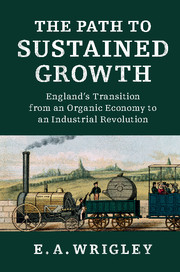 The Path to Sustained Growth
The Path to Sustained Growth Book contents
- Frontmatter
- Dedication
- Contents
- List of figures
- List of tables
- Acknowledgements
- Introduction
- 1 Organic economies
- 2 The classical economists
- 3 Energy consumption
- 4 Urban growth and agricultural productivity
- 5 Changing occupational structure and consumer demand
- 6 Demography and the economy
- 7 Transport
- 8 England in 1831
- 9 The completion of the industrial revolution
- 10 Review and reflection
- Bibliography
- Index
8 - England in 1831
Published online by Cambridge University Press: 05 January 2016
- Frontmatter
- Dedication
- Contents
- List of figures
- List of tables
- Acknowledgements
- Introduction
- 1 Organic economies
- 2 The classical economists
- 3 Energy consumption
- 4 Urban growth and agricultural productivity
- 5 Changing occupational structure and consumer demand
- 6 Demography and the economy
- 7 Transport
- 8 England in 1831
- 9 The completion of the industrial revolution
- 10 Review and reflection
- Bibliography
- Index
Summary
In 1831 England was entering the last phase of the long process of change that came to be termed an ‘industrial revolution’. Following the invention and steady improvement of the efficiency of the steam engine, coal was able to transform the supply of mechanical energy as it had already transformed the supply of heat energy, but this second advance was in its early stages in 1831. Land transport, for example, still remained almost exclusively dependent on the traditional sources of energy in organic economies, but in 1830 the dawn of a new transport era was symbolised by the opening of the first commercially successful railway line between Liverpool and Manchester, providing both passenger and freight facilities, and depending exclusively on the traction power of the steam engine. The country was on the eve of the construction of a railway network on which the steam engine could transport both goods and passengers on a scale and at a speed that greatly exceeded anything previously achieved. In the following year the fourth national census was taken. It provides a revealing insight into several aspects of the English economy as it was about to enter the period when the supply of mechanical energy was transformed in a fashion that paralleled what had happened earlier with heat energy. During the middle decades of the nineteenth century, roughly between the 1830s and 1870s, the use of steam engines as the source of mechanical energy became general in all branches of industrial production. With the supply of both energy types freed from dependence on plant photosynthesis, a prolonged period of exponential growth became possible – an industrial revolution.
The unusual character of the 1831 census
The 1831 census was the fourth and last census that Rickman directed. Like all earlier and later censuses it provided counts of the totals of men and women alive at the time but it had a number of features which distinguish it from other censuses, features which are at once frustrating in that there is often no directly comparable information in later censuses and illuminating in that it provides an insight into aspects of the structure of the economy which might otherwise have remained largely invisible.
- Type
- Chapter
- Information
- The Path to Sustained GrowthEngland's Transition from an Organic Economy to an Industrial Revolution, pp. 151 - 172Publisher: Cambridge University PressPrint publication year: 2016


